Outreach: Member outreach activities
Issue: Imaging
13 February 2018 article
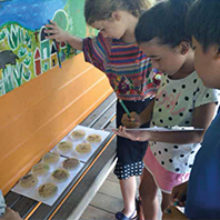
Microbiology Society members regularly do new and inspiring outreach activities supported by the Society. Through our grants, we have assisted many education and outreach activities including these two projects that took place in French Guiana and Sheffield, UK.
Microbiology Society members Dr Helen Brown and Michael Pascoe took an outreach programme, Science in Schools, to French Guiana to encourage interactive science learning in the region. Below is a summary from Helen and Michael about their trip.
During October, we participated in a week-long outreach programme in French Guiana, a tropical region of France nestled between Brazil and Suriname. The programme, dubbed ‘Science in Schools’, was a collaboration between the British Council and French Ministry of Education, which aimed to bring interactive science learning to the students living in the region. By teaching the students through the medium of English, the programme helped children to learn fundamental scientific concepts while practicing their language skills with STEM professionals.
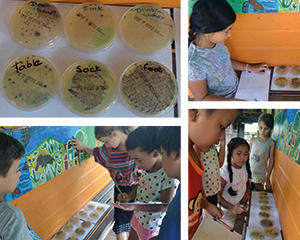
In each session, we delivered three activities that covered the fundamentals of microbiology. The first activity consisted of taking swabs from various sources to see how prevalent microbes are. The children were particularly excited when they discovered they could test which toilets were dirtier: the girls’ or the boys’! The second used Giant Microbes to introduce pupils to some of the most common disease-causing microbes in humans, as well as some which comprise our microbiome and contribute to health. The final activity was ‘Blast-a-Biofilm’, which uses water pistols and hair gel, and introduces the students to the concept of biofilms using the example of dental plaque. This also helped them to understand the role brushing teeth plays in preventing dental caries. In addition to interacting with pupils, we also ran a masterclass with trainee teachers at the Université de Guyane so that they could learn how to incorporate interactive learning methods into their own lesson plans.
Over the course of the week, we travelled to five major areas of French Guiana, including Maripasoula, Cacao, Kourou, Cayenne and Saint-Georges-de-l’Oyapock. The communities in each of these areas had a distinct background including Creole, Hmong, Metropolitan French and native peoples, and demonstrated that French Guianan society was a true cultural mosaic. Reaching these isolated and economically deprived areas also required unusual transport arrangements. Maripasoula was an hour’s flight over the Amazon in a very small plane (think Indiana Jones!) while the village of Trois Palétuviers was reachable only by catching a 45-minute ride downstream of Saint-Georges in a pirogue.
Transporting learning props to remote communities and finding a suitable parking space on the river added another layer of complication to the daily commute.
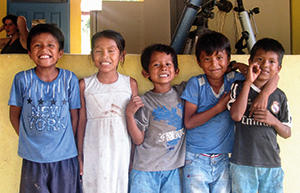
Although we’ve previously engaged in outreach in the UK, participating in Science in Schools was a uniquely challenging experience. As many of the students had limited English skills, we had to think carefully about the key messages that we wanted to convey and how to do that in the most simple terms. However, the satisfaction we both felt from teaching these children certainly made the experience one we will treasure and remember fondly for the rest of our lives.
We would like to thank the British Council for arranging our participation in the Science in Schools programme and funding the trip, the Microbiology Society for awarding the outreach grant to purchase many of the learning materials, and to Cardiff Institute of Tissue Engineering and Repair (CITER) for providing cloths, posters and badges. Special thanks go to all the pupils and teachers of the schools we visited, and especially the staff of Académie de Guyane for making us feel so welcome and ensuring we got to where we needed to be. If you are interested in finding out more about the British Council’s Science in Schools programme, you can visit the website.
The Horror Within
Society members Kirstie Rawson, Mel Lacey, Sarah Forbes, Emma Henly and Alex Andrews were part of a team who ran an event about the human microbiome with a ‘spooky’ Halloween spin. Below is a summary from Kirstie about how a Microbiology Society grant supported this great evening.
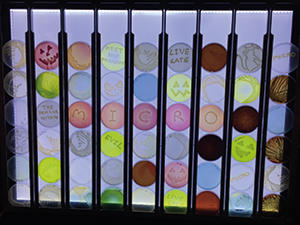
The human body has several unique ecological niches and is home to a plethora of diverse micro-organisms. From aiding in digestive processes to fighting off invading pathogens, this invisible community plays a significant role in maintaining the health of the human host. This project aimed to establish a new outreach exhibition with which to educate the public on the importance and multiple roles of their microbiome. To do this, we planned to build a light box to showcase many different Petri dishes with different selective agars and bacteria on, and show this at a small event at the local museum. The grant was originally awarded for an adult education evening but during the planning stages, we quickly realised we could make the event bigger and decided to run the event as a science-fuelled horror exhibition for Halloween. Colleagues at Sheffield Hallam University were successful in a subsequent grant application from the Royal College of Pathologists, which enabled us to provide a series of wet experiments throughout the event. The Horror Within was born: an adult-only, after hours, social event which was part of Millennium Gallery’s Live Late series, hosted on Friday 27 October 2017.
A series of mini-lectures spanned the evening, covering a variety of topics from the importance of your microbiome at birth and the importance of poo, to the plague apocalypse and the horrors encountered in laboratory diagnostics. Running parallel to the lecture sessions were a number of experiments, including the extraction of DNA from cheeks and fruit, discovering parasitic worms and a “make your own poo” stall. The experiments were a massive success as they tied in nicely with our lectures, and people loved getting stuck in! There were also several exhibits, including our light box, which allowed a more informal, but more detailed discussion of microbiology.
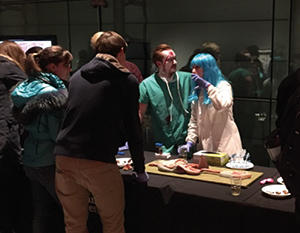
The feedback from the event was very positive; those who attended gave us an average of over 4.5 out of 5 stars. On asking people what their favourite part of the event was, a selection of comments were: “agar plates looked super pretty and the bugs came from different areas of the body which was interesting!”; “about how small bacteria actually [are] and how [they] can affect the human body,” and “all of it! It was brill.” Interestingly, over 40% of those who visited the event hadn’t visited a science museum, science festival or a laboratory in the last year, meaning that we engaged with many people who do not usually engage in science. We are delighted with this as it meant we achieved our goal of providing an evening that was not only educational, but interactive and enjoyable too. I would like to thank the Microbiology Society once more for supporting our vision, and we will be using the light box at many future outreach events.
Are you running any outreach events?
If you are running any education and outreach events, we want to hear about them. Please email [email protected].
